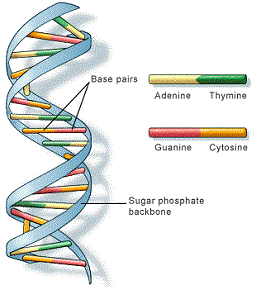Molecular Basis of Inheritance - Online Test
Q1. Genetic information is carried out by long chain molecule made up of
Answer : Option C
Explaination / Solution:
Genetic information is carried out by DNA and RNA. Both DNA and RNA are called genetic material, made up of long chain of nucleotide having- nitrogenous base, sugar and phosphate ions.
Q2. Name the conjugated protein used as genetic material in living cells
Answer : Option D
Explaination / Solution:
Nucleoprotein, conjugated protein consisting of a protein linked to a nucleic acid, either DNA (deoxyribonucleic acid) or RNA (ribonucleic acid). The protein combined with DNA is commonly either histone or protamine; the resulting nucleoproteins are found in chromosomes.
Q3. By which bonds the purine & pyrimidine pairs of Complementary Strands of DNA held together?
Answer : Option D
Explaination / Solution:
Three hydrogen bonds form between guanine and cytosine. Two hydrogen bonds form between adenine and thymine or adenine and uracil. Complementary pairs always involve one purine and one pyrimidine base.
Q4. There is no DNA in
Answer : Option D
Explaination / Solution:
Because of the lack of nuclei and organelles, mature red blood cells do not contain DNA and cannot synthesize any RNA, and consequently cannot divide and have limited repair capabilities. The inability to carry out protein synthesis means that no virus can evolve to target mammalian red blood cells.
Q5. DNA is made of two chains that twist about one another in the shape of a
Answer : Option C
Explaination / Solution:
Double helix is the description of the structure of a DNA molecule. A DNA molecule consists of two strands that wind around each other like a twisted ladder. Each strand has a backbone made of alternating groups of sugar (deoxyribose) and phosphate groups.

Q6. _____ occurs in RNA instead of the nitrogenous base thymine found in DNA.
Answer : Option B
Explaination / Solution:
Uracil is one of the four nucleobases in the nucleic acid of RNA that are represented by the letters A, G, C and U. The others are adenine, cytosine, and guanine. In RNA, uracil binds to adenine via two hydrogen bonds.
Q7. Which ratio is constant for DNA
Answer : Option D
Explaination / Solution:
In DNA, adenine bind with thymine and guanine binds with cytosine. So, sum of adenine and guanine is equal to sum of thymine and cytosine.
Q8. The term gene was coined by
Answer : Option D
Explaination / Solution:
The term gene was coined by Johannsen in 1909. He defined gene to be elementary unit of inheritance that specifies the expression of a particular trait.
Q9. Which of the following is structural subunit of DNA?
Answer : Option A
Explaination / Solution:
Consisting of a five-carbon sugar (deoxyribose) a phosphate group and a nitrogenous base, a nucleotide links with another nucleotides in a repeating sequence, forming a very long, continuous strand of DNA.
The nitrogenous base will be one of four types: Guanine(G), Adenine (A), Cytosine (C) or Thymine (T).
Q10. In a DNA strand the nucleotides are held together by:
Answer : Option B
Explaination / Solution:
When nucleotides are incorporated into DNA, adjacent nucleotides are linked by a phosphodiester bond: a covalent bond is formed between the 5' phosphate group of one nucleotide and the 3'-OH group of another.
In this manner, each strand of DNA has a “backbone” of phosphate-sugar-phosphate-sugar-phosphate
